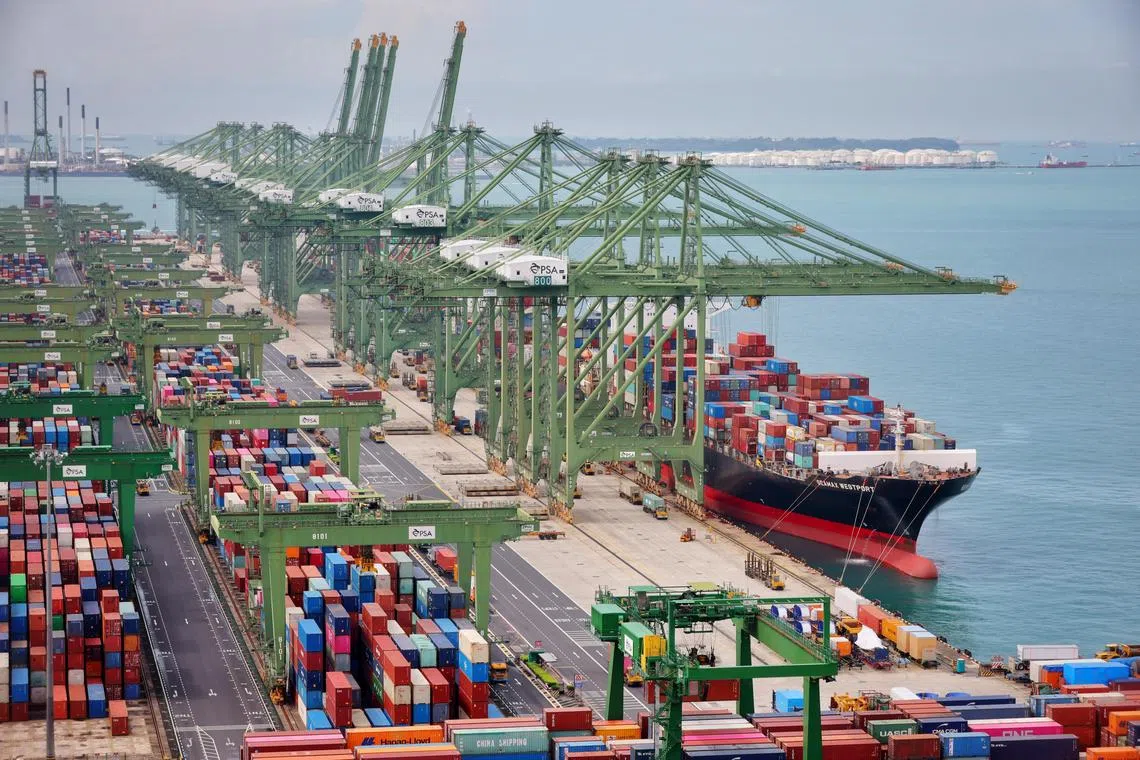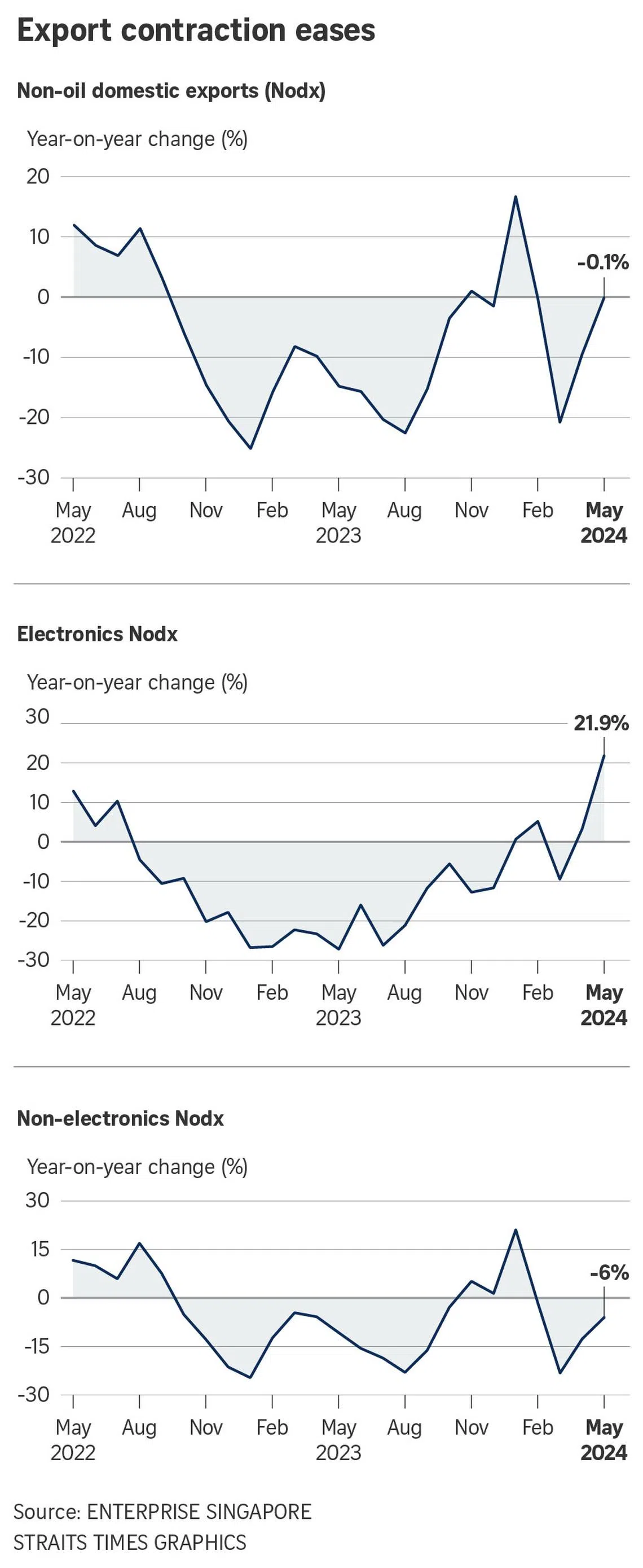Singapore’s key exports dip 0.1% in May, mildest decline in 20 months
Sign up now: Get ST's newsletters delivered to your inbox

Electronics exports posted the first double-digit growth in 22 months.
PHOTO: ST FILE
Follow topic:
SINGAPORE – The slump in Singapore’s key exports may have ended, economists said, after data for May came in better than expected, with the recovery being driven by tech demand related to artificial intelligence (AI).
Non-oil domestic exports (Nodx) dipped 0.1 per cent year on year in May after shrinking a revised 9.6 per cent in April.
While this marked the fourth straight month of contraction, it was the mildest decline in 20 months, trade agency Enterprise Singapore (EnterpriseSG) noted on June 18. It also beat the 1.1 per cent drop forecast by economists in a Bloomberg poll.
Electronics exports posted the first double-digit growth in 22 months. They grew 21.9 per cent year on year in May, extending the 3.3 per cent increase in April.
The growth in electronics Nodx was driven by integrated circuits (ICs), also referred to as chips or semiconductors.
Year on year, shipments of ICs – which make up about half of electronics exports – grew 35.8 per cent to $1.9 billion.
Exports of disk media products jumped 92 per cent from a year ago to $571.5 million, while personal computers (PCs) grew 27.2 per cent to $286.9 million.
The ongoing recovery in the global tech cycle will have positive spillovers on Singapore’s electronics shipments, said DBS Bank economist Chua Han Teng.
Global tech demand is picking up, driven by the need to replace smartphones and PCs, as well as the growing use of AI applications, he added.
Oxford Economics’ economist Sheana Yue noted that some businesses are investing heavily in chips again to ride the AI wave. Others are diversifying the locations of their manufacturing bases to hedge against geopolitical risks, chiefly, escalating tensions between the United States and China.
Singapore appears to be benefiting from these shifts in the electronics trade flows, Ms Yue said.
In the latest such news, Applied Materials, one of the world’s top suppliers of chipmaking machines, said it plans to double its Singapore manufacturing capacity
On June 5, Vanguard International Semiconductor, which is backed by Taiwan Semiconductor Manufacturing Co or TSMC, said it is building a US$7.8 billion (S$10.6 billion) wafer chip plant in Singapore
Semiconductor and electronics exports should lead this recovery in domestic exports, said ANZ’s head of Asia research Khoon Goh.
Mr Goh said pharmaceutical exports, which have been extremely weak in the past few months, should recover as well.
In May, pharmaceutical shipments slipped for the third consecutive month, falling by 37.5 per cent to $839.5 million.
That weighed on non-electronics shipments, which shrank 6 per cent from the previous year. This follows a 12.6 per cent contraction in April.

The decline in non-electronics Nodx was also driven by non-monetary gold, which contracted by 47.2 per cent from a high base a year ago.
“Both these data (pharmaceutical and non-monetary gold) are highly volatile. We can expect them to unwind in the coming months, which should result in a rebound in the headline Nodx figures,” Mr Goh added.
Still, the analysts warned that recovery will be gradual and bumpy over 2024.
Ms Yue said monetary policy in the United States and the European Union will likely remain relatively tight, weighing on economic growth and demand for Singapore’s exports from these key markets.
By markets, shipments to Singapore’s top 10 markets as a whole grew in May.
Notably, shipments to the United States recovered from April’s fall to expand 12.1 per cent.
However, shipments to China slipped into the red, falling 22.1 per cent.
Singapore’s exports to the European Union also remained weak, falling another 8.7 per cent in May, and shipments to Japan reversed April’s gains to contract 12.7 per cent.
On a month-on-month seasonally adjusted basis, which removes the effects of seasonal variations in the numbers, Nodx declined 0.1 per cent in May, after a revised 7.3 per cent increase in April.
In value terms, May Nodx came to $13.9 billion, similar to the previous month’s $13.9 billion but lower than the year-ago level of $14 billion and 2023’s average of $14.5 billion.
DBS’ Mr Chua said there are still ongoing global uncertainties that could hinder the manufacturing recovery. Some headwinds include geopolitical conflicts that could still disrupt supply chains, tensions between the US and China, as well as uncertainty over the timing and extent of US interest rate cuts.
EnterpriseSG said in May that Singapore now expects growth in key exports to come in at the lower end of the range of 4 per cent to 6 per cent growth forecast in 2024.
This followed a disappointing start to the year, when Nodx fell 3.4 per cent to around $42 billion in the first quarter of 2024.


